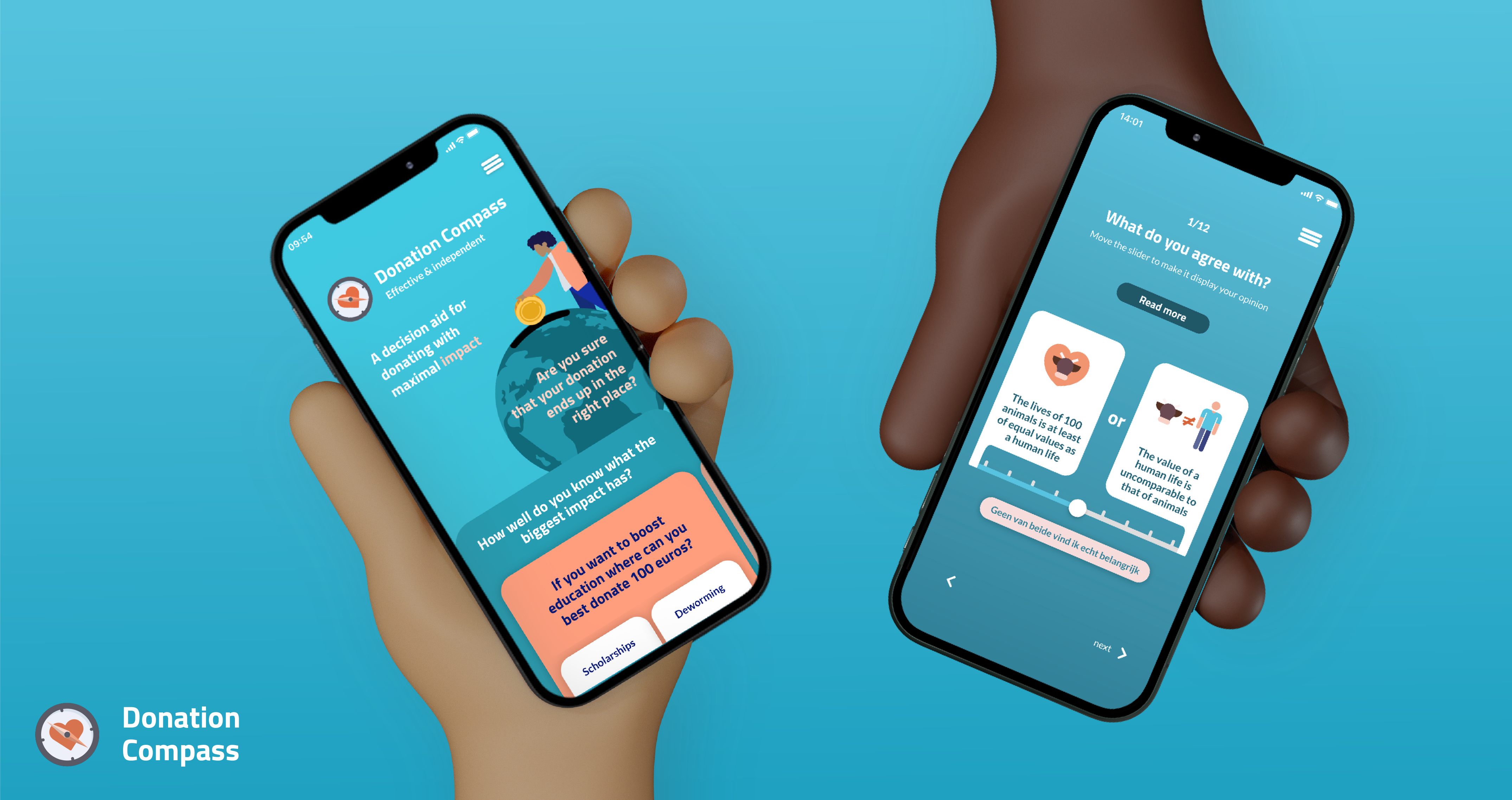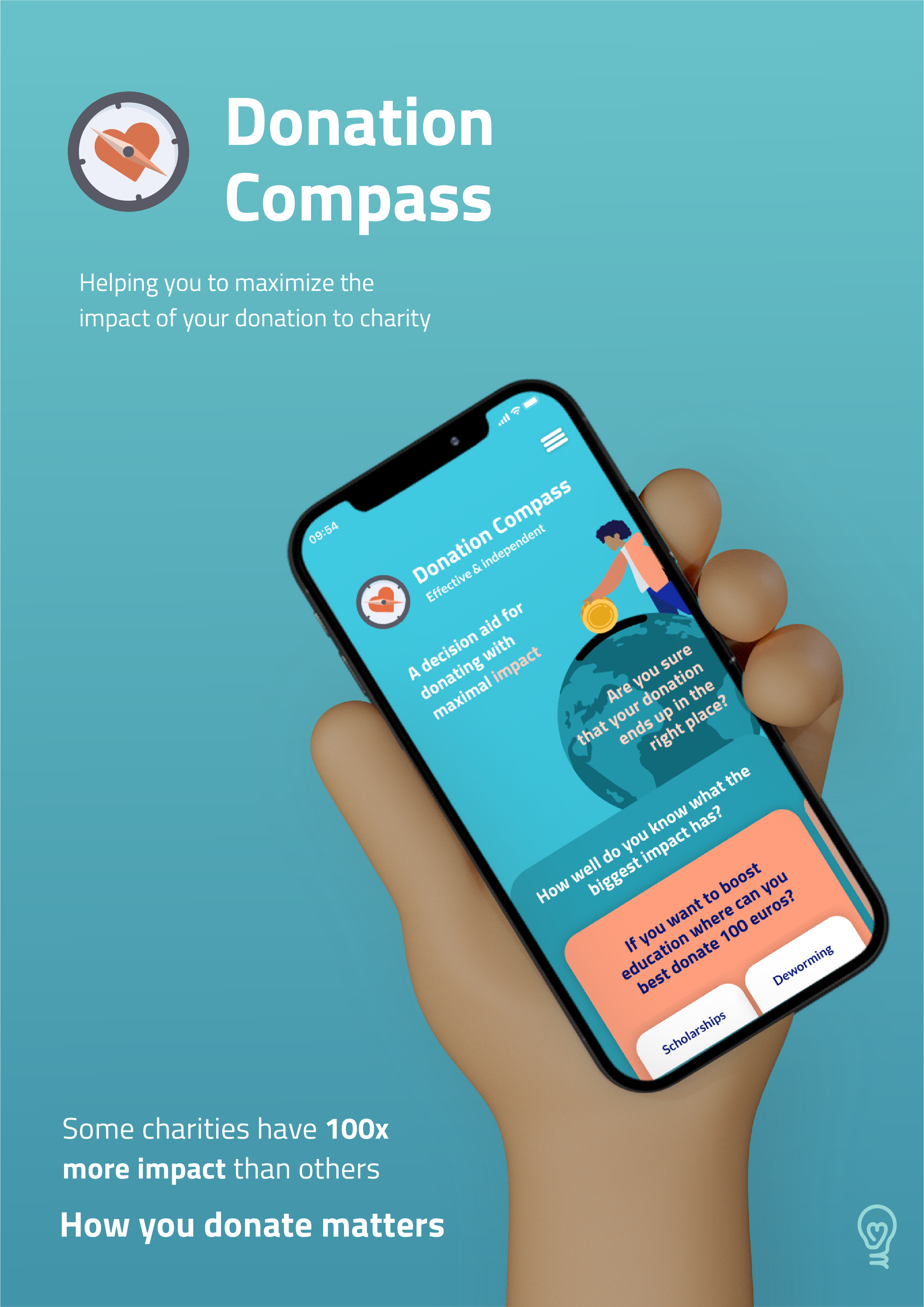Why disciplines, like design, can have added value for Effective Altruism
I am a designer and I am currently contributing to Effective Altruism in the Netherlands (though this is an article written from my personal perspective entirely). Using my humanity-centred design skill set, I have been developing a conceptual web tool that guides people in their effective donation journey; the Donation Compass. Due to my personal experience as an outsider at the EA Netherlands, I believe we need more disruptive outsiders with a greater diversity of skills. Because outsiders have a lot more to offer than first meets the eye.

I initially got involved with EA Netherlands because I was seeking a project client for my studies in Industrial Design. EA Netherlands eventually agreed to coach and support this project. Now you might think; What can someone with a design background contribute to a philosophical movement like Effective Altruism? Not only design but many other disciplines are often viewed with skepticism regarding their potential for direct contribution to EA.
In this article I will therefore outline why disciplinary diversity is important for EA. Meanwhile, I will provide examples based on my experiences and showcase the midpoint outputs of my own project.
Outsiders bring new perspectives
Firstly, the EA community needs outsiders with new perspectives because these people are likely to identify important issues that others would have missed. The EA community is a rather homogeneous group of people. EA’s are often white, highly-educated, male, and have expertise in the computer and other quantitative sciences. While homogeneity makes for harmony and mutual understanding, it also comes with the risk of bubble formation. How we view the world can never be completely objective; it is shaped by our background and culture. People with the same background therefore often have similar perspectives on the world and on the problems that exist in this world. This is problematic since today’s world is just too complex for an individual to grasp every aspect of it. There is thus a high likelihood that important problems will be (dis)missed if all people in the EA community have the same perspective.
Looking through my designer’s lense at the EA movement, I for example noticed shortcomings in the current methods of communication. Designers attribute great importance to the aesthetics and user-friendliness of everything that is created. When I, however, look at the ‘products’ that are created in the EA community, they often lack a certain aesthetic interaction. Most of the ‘products’ are scientific texts or data analyses. These ‘products’ are generally difficult to digest for a recipient and they spark little imagination. Through these observations, I, therefore, saw an opportunity in changing how we communicate about EA.
Outsiders bring new networks
A lack of outsiders also limits the amount of people that would initially get exposed to the ideas of EA and thus limits the spread of the EA mindset and ‘lifestyle’. I believe that for the EA community there is great truth in the quote; ‘Your network is your net worth’. This relates to the importance of a great and diverse network of experts to support and grow the cause of EA. Because when the same kinds of people are always working on important EA projects, the outcomes are likely tailored to, and mostly only reach these same kinds of people. Moreover, people often get involved with a cause because they identify with the supporters of that cause. If all the role models of EA are merely young academics; this will likely also hinder the general growth of the movement.
I also experienced what value my own network could bring to EA. I could access much-needed expertise that the Dutch EA community hadn’t had access to before. The Dutch EA community didn’t have a lot of professional web development expertise. Through my network of university friends, I could quickly connect with multiple people who could, for an affordable rate, take on some web-development tasks. Also, a friend of mine is a filmmaker. Due to my personal stories, I got him excited about taking on a side project with me. Together we created a 2-minute film (see below) that illustrates the effects of ineffective donation.
Outsiders bring new approaches & solutions
Figuring out what the core of a problem is and solving it, can benefit from the contribution of outsiders. Because the multidisciplinarity that they bring, will give rise to innovative findings and thus better final solutions. What you identify as the origin of a problem is likely affected by your expertise. If both a psychologist and sociologist are, for example, tasked to find the main cause of homelessness, the methods they employ to find their answers and what clues they pay attention to are likely different. The psychologist will pay more attention to the individual, while the sociologist sees mostly collective processes. Due to this they will also arrive at different conclusions, both of which are likely to contain truth and thus value in tackling.
If you get handed a problem; what method would you employ to tackle it? The method of your choice is likely also aligned with where your expertise lies. This is known as Maslow’s hammer; “If all you have is a hammer, everything looks like a nail”. For problems of today’s complex nature, there is often not one straightforward method to ‘solve’ it. It is, therefore, crucial to experiment with a multitude of approaches and find which ones have the greatest merit in every situation. Both figuring out the problem and solving it can thus benefit from a multi-disciplinary approach.
I believe that as a designer I can, for instance, contribute through my networked, iterative, and human-centred approach. The challenge I took on for EA Netherlands was to develop a concept that would get more people over 40 engaged in effective giving. Just like in most projects a designer takes on, I had little prior knowledge about the topic. Using methodologies from design, like co-reflective interviews with the target group and co-creation workshops with experts, I immersed myself in the context. Through this, I explored the barriers to effective giving in the Netherlands. Based on these identified barriers, I then iteratively started to formulate the origin of the problem and the proposed solution. For every iteration, I created a conceptual prototype to validate my hypotheses with experts and with the target group.
As of writing this, I am at a stage where a clear concept has taken shape. This is ‘het DoneerKompas’ (the Donation Compass); an online platform that guides people in making an effective donation decision through triggers, a quiz, and a simple aggregation of effective charities.

This project was initially conducted for my studies as a collaboration with EA Netherlands. As the project within my studies is now coming to an end, I will continue my collaboration with EA Netherlands. I am now in the phase of compiling a team of EA’s to help me develop the platform for launch. All in all, very exciting, and I think it is already a proof of concept that you can have real added value in the EA community as an outsider.
Getting involved as an outsider
But then the question still remains of how you would initially get involved as an outsider. Here I again see great similarities with my conventional design practice. For the designer it is often not straightforward how they can best contribute to a project. This therefore needs elaborate reflection and strategising. For outsiders in the EA community, it is also often not straightforward why their discipline has relevance. Try thinking out of the box, what skills could be applied in a new context? Or what relevant network or perspective can you offer?
I also see similarities because designers are usually the ‘outsider’ in a project team. It is often unclear to clients what design can contribute in their context. This is because very few people outside of the design community understand what a designer does. Communicating what you do as a designer and why this has added value for the other party is thus a crucial part of your practice. For the EA outsider, I also believe that clear communication about your unique assets and qualities is essential so that others understand why you are relevant.
And while I think that design can bring great value to EA, please interpret this story in its more general sense. That your perspective, network, and approach are likely to be relevant for EA in some shape or form. So please go be the outsider and create something!
This all is of course my story and experience from the singular disciplinary perspective of a designer. I am therefore very curious about what your experiences as an ‘EA outsider’ have been like and how you were able to contribute.

I strongly upvoted this post, since I am a UI/UX designer myself! I also think the EA community needs more designers, and more generally we also need "outsiders" or people with backgrounds/skills not well-represented currently in the community.
Your designs look great, and I have a few comments on what you wrote:
2. I agree quite a lot with this too. Maybe you can volunteer or be a contractor for some EA organizations to make graphics or interactive tools to make their reports more accessible and digestible.
Thanks for this perspective! I'm excited to see your 2-min video about ineffective donations, but there is an error message at the moment.
Oops, I reposted the video and therefore the link changed. It is now updated!
I've also noticed many "products" in the EA community that seem to have been created without much/any thought toward design.
I both agree with your specific argument that designers could make efforts in EA more impactful, and with your general argument that a diversity of skillsets would help EA in a variety of ways.